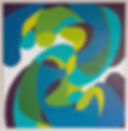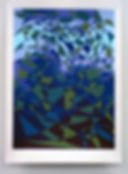
Tom Loveday, The Fourth Dimension
Mais Wright Gallery, 2024
see, https://www.maiswright.com/artists/tom-loveday/tom-loveday-exhibitions/
Art conjures presence, but of what?
I {want] to bring about some fresh way of seeing again what had already almost certainly been experienced, but which had been either dismissed or buried by the passage of time; that thrill of pleasure that sight itself reveals.
Colour is the proper means for what I want to do because it is prone to inflections and inductions existing only through relationship; malleable yet tough and resilient. I do not seek single colours but rather pairs, triads or groups of colour …
(Bridget Riley (Robert Kudielka ed), The Eye’s Mind, Bridget Riley, Collected Writings, 1965-1999, Thames and Hudson, p. 33.)
In geometry, four-dimensional space appears by counting 1, 2 and 3 lines in a sequence equally separated by 90 degrees to each other. The result is the very familiar three axes of spatial geometry. This counting of the axes inevitably leads the imagination to ask if there could be more numbers, lines or more dimensions.
However, adding another line that maintains the rule that all axes must be at 90 degrees to each other, is rather tricky. Where does this new dimension go? This makes imagining four-dimensional geometry in “reality” quite difficult (but not impossible as I have explained elsewhere.) Instead of trying to add another line, let’s suppose that the fourth dimension can be a line of colour added to the first three dimensions. We could call this colour line a “Cline” as I did in a theoretical paper in the late 1990s. (The term Cline refers to a gradual change over distance and time, especially in the surface temperature of the ocean. My Cline is a gradual change over distance and time in colour.)
Calling a Colour line (or “Cline”) a fourth dimension avoids the problem of where the fourth dimension is to be placed. Indeed, colour becomes a quality of all the first three lines in much the same way as each dimension adds a dimensional quality to the other dimension lines but without affecting them in quantity. Adding the Cline simply makes a three-dimensional space four dimensional.
However, this is a difficult proposition in painting because colour as mostly regarded as the creator of confusion in an otherwise colourless cosmos. Colour upsets the pure black and white representation of pure abstract geometry by changing its spatial reading – colours, among other things, recede and advance differently to the strict geometry of linear perspective. In European painting, this meant that drawing was regarded as more basic than colour – something to be wary of and taught after drawing. “atmospheric colour” needed to be bound to the rule of perspective otherwise art was in chaos. To see the fourth dimension in these works, one needs another idea.
This idea exists in understanding the difference between the simple geometry explanation of the fourth dimension and its popular culture reception. The term “dimension” becomes a space in the popular culture. Various authors and film makers have used the fourth dimension as a space from which mystery and danger emerges because such a space is the great unknowable. Films such as Forbidden Planet, for example build hysterical ideas about “the invisible” from the fourth dimension as a menace upon the invisible.
However, this elision of a dimension line and a space can be a productive approach to making art. If we say that each painting is a pictorial dimension, then each painting can be thought of as one of dimensions that make up a space. Indeed, each pictorial space is a geometrically coloured “line” that when place in an axial relationship with three other paintings, creates a four-dimensional space.
So now we have two ideas: colour as a dimension line and a painting as a spatial dimension: The doubling of the quadruple. This leads to the next step in this exhibition: the four-panel works are four, four-dimensional spaces at 90 degrees to each other. From there, why not have multi-dimensional spaces, for this exhibition, 15 four-dimensional panels?
I fear, dear reader, I may have lost you with all this peculiar geometric chatter along with some odd idea about colour, pictoriality, metaphor and other difficulties inflected by various ancient ideas about art and thought such as Nominalism. I hope though that the works speak at some level, for themselves – offering a feeling about two of the most primary features of human existence: geometry and colour, out of which presence appears in systems of aesthetics. For me, this is how art conjures the presence of human civilisation itself, something way may be in dire need of soon.


















Tom Loveday and Lisa Jones, Hiding in the Shadows
Five Walls Projects, 2022
While this was not strictly a solo show, I think of it as such. Lisa and I worked together with a single idea to which we responded within our respective art practices. Also, in order to affirm our working together we chose quotes rather than theoretical essays to accompany the exhibition.
For Lisa Jones:
And who would not be inspired to take his departure if his words could strike to the heart of Berlin, as Hessel does with his Muses from Magdeburger Strasse? “They have long since vanished. Like quarry stones they stood there decorously holding their ball or pencil, those that still had hands. Their white, stone eyes followed our footsteps, and the fact that these heathen girls gazed at us has become part of our lives.”
And: “We see only what looks at us. We can do only… what we cannot help doing.” The philosophy of the flâneur has never been more profoundly grasped than in these words of Hessel’s.
Walter Benjamin, The Return of the Flâneur, in (Michael W Jennings et al eds), Walter Benjamin, Selected Writings, Volume 2, Part 1, 1927-1930, Belknap Press and Harvard University, 1999, p. 265.
Lisa's works:
Lisa Jones, Beneath our feet, 2020 – 2021, Pencil on 360gsm Khadi paper, 30 x 30 cm to 56 x 56 cm.
For Tom Loveday:
Short Shadows. Towards noon, shadows are no more than sharp, black edges at the feet of things, preparing to retreat silently, unnoticed, into their burrow, their secret being. Then, in its compressed, cowering fullness, comes the hour of Zarathustra – the thinker in “the noon of life,” in “the summer garden.” For it is knowledge that gives things their sharpest outline, like the sun at its zenith.
(Walter Benjamin, 1929, in Michael W Jennings, Howard Eiland and Gary Smith, Editors, Walter Benjamin, selected writings Volume 2, part 1 1927-1930, Belknap Press, 2005, p. 272.)
Look, it is coming, it is near, the great noon.
(Zarathustra, in Friedrich Nietzsche (Adrian del Caro trans and ed and Robert Pippin ed), Thus Spoke Zarathustra, Cambridge University Press, 2006, p 153.)
My works:
Tom Loveday, Dark Edge, 2022, 52 panels, synthetic polymer paint on heavy weight plastic tracing film, each panel 29.7 x 42 cm, overall dimensions variable.
Tom Loveday, Over the Edge
Kronenberg Mais Wright Gallery (Now Mais Wright Gallery) 2022
Over the Edge is one of a series of exhibitions of “Edge” paintings, as indicated in their titles. The series consists of The Edge of the World, The Erotic Edge, The Edge of Reality and Over the Edge. Produced over a period of 8 years, each exhibition in the series experiments with ideas about colour, geometry and space using a range of techniques drawn from 1960s Op Art, especially the work of Bridget Riley and Victor Vasarely.









Tom Loveday, Edge of Reality
Kronenberg Mais Wright Gallery (Now Mais Wright Gallery) 2018
Copies of the artist talk and room sheet essay can be found at:
https://www.academia.edu/37460978/The_Edge_of_Reality
https://www.academia.edu/37460974/The_Edge_of_Reality
Tom Loveday, Edge of Reality 4, 2018, Acrylic On Canvas 107 x 107 cm can be seen at Artbank, https://www.artbank.gov.au/search









Tom Loveday, Erotic Painting
Conny Dietszchold Gallery 2017
Copies of the artist talk and room sheet essay from the exhibition of these works can be found at:
https://www.academia.edu/37460978/The_Edge_of_Reality
https://www.academia.edu/37460974/The_Edge_of_Reality
Tom Loveday, Edge of Reality 4, 2018, Acrylic On Canvas 107 x 107 cm can be seen at Artbank,









Tom Loveday, Infrathin Advice for Aliens
Wollongong Art Gallery, 2015
Infrathin, Advice for Aliens is a mixed media work consisting of an array of 54 small paintings, 3 larger paintings, a book and a video. The exhibition uses the Duchampian idea, “infrathin” and linguistic play on the words “alien” and “alienation.” Infrathin: Advice for Aliens is addressed to “aliens.” For aliens, there is no distinction between representation and reality – the world is simulacra. This is because aliens, being from another world, have no compatible world-view with here and now, no sense of the hierarchy of objects that we have and no grasp of the signs by which we navigate the world and construct “reality.” Alienation thereby seems to be pathological to us and so they need our help to survive. Meaning is reduced to its most superficial, the aesthetically minimal and the surface effects of symbols and shapes in painting, moving image and text.










Tom Loveday, Alien Song, 2012, Sample 1

Tom Loveday, Alien Song, 2012, Sample 2

Tom Loveday, Alien Song, 2012, Sample 2
Tom Loveday, Textworks
Peloton Art Projects 2014
Text works with video and colour.









Tom Loveday , Textworks, 2014, video installation, in Textworks, 2014, Peloton Art Projects
Tom Loveday, The Edge of the World
Conny Dietszchold Gallery 2013
Colour is not a quality. Colour is a power.









Tom Loveday, Memorial
Dominik Mersch Gallery, 2009









Tom Loveday, The Planets
Sydney College of the Art, University of Sydney 2004-6









Tom Loveday, Flat
Sydney College of the Arts University of Sydney 2002












